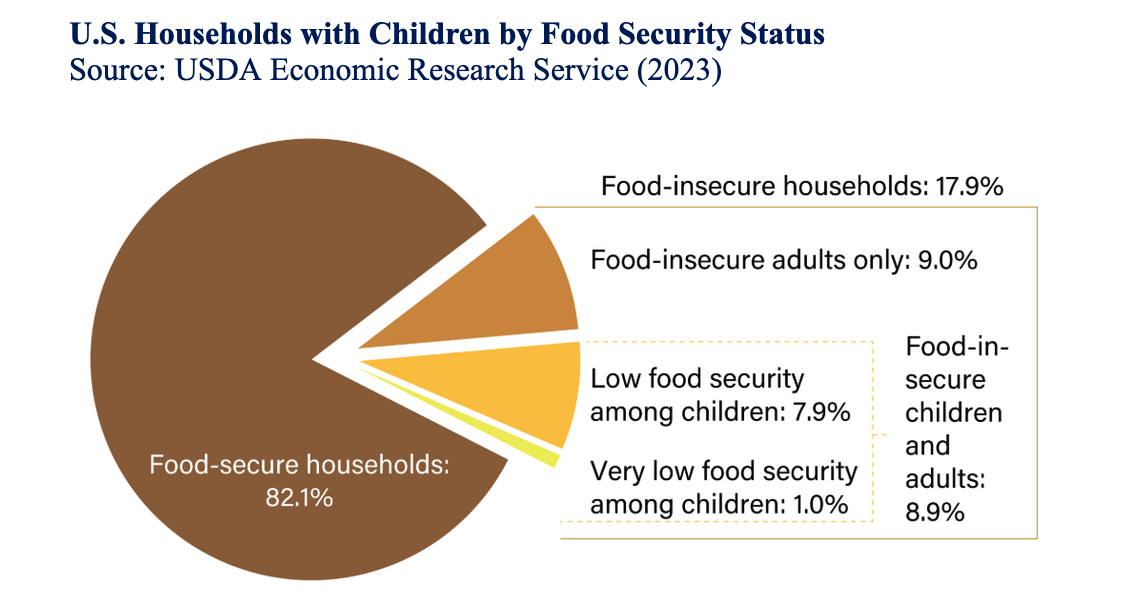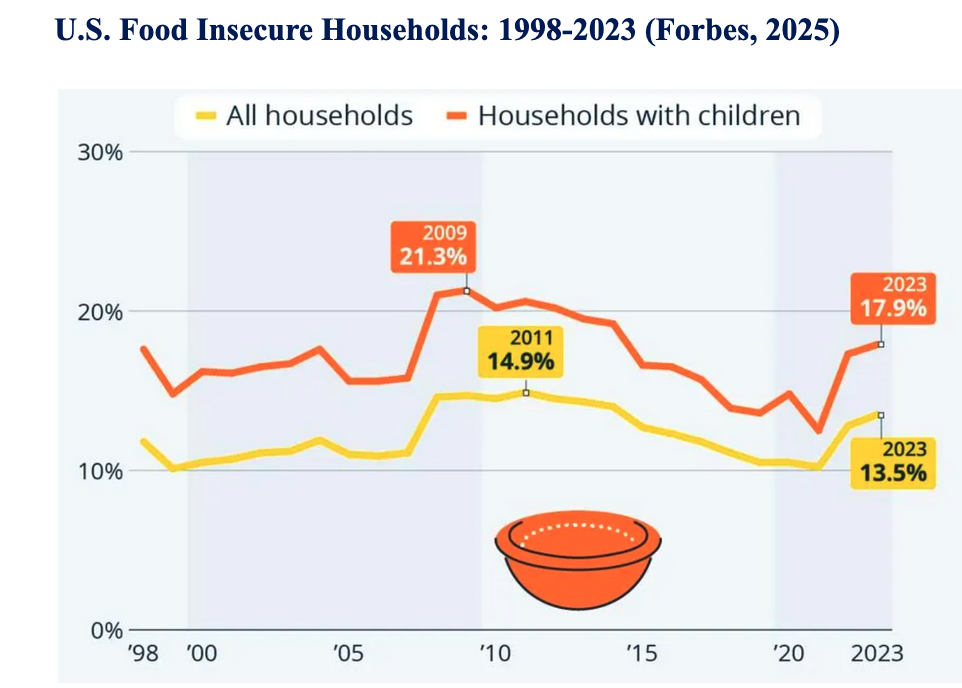November marks the beginning of the holiday season – holiday parties, breaks from school, and family gatherings. For many, it is also a time of gastronomic indulgences – turkey, stuffing, cranberry sauce, pumpkin pie, ham, crab cakes (if you are in Maryland), or perhaps baked macaroni and cheese – depending on your family traditions. As the holiday season begins this fall, it is always an exciting time of year, but it is also a time of stress and pressure for some families who are less fortunate as they try to make ends meet amid the varied celebrations. In this issue, we explore food insecurity, food and nutrition, and culturally responsive teaching to provide data and resources to feed your conversations around the table and fill your heart as you make decisions about your own philanthropy to support toy, school supply, clothing, and food drives over the next few months.
Food insecurity is top of mind for many Americans and service providers, from federal workers to food banks. It is an urgent and growing issue that has been well documented. According to the USDA Economic Research Service, 13.5% of U.S. households —approximately 47 million Americans —experience some level of food insecurity (USDA, 2023).
[Learn more about how the USDA tracks Food Security here.]
The data for “households with children” is even more shocking. As shown in the graphs below, nearly one in five households with children reported experiencing some level of food insecurity over a 12-month period. 9% reported food insecurity among adults only, while another 8.9% reported food insecurity for both adults and children in the household.

As shown below, the level of food insecurity in 2023 approached levels seen during the period of “economic weakness” that followed the 2008 financial crisis and recession. Interestingly, relative lows in food insecurity were “achieved” during the COVID-19 period from 2020 to 2022.

In numbers, this means that
- 47.4 million people lived in food-insecure households.
- 12.2 million adults lived in households with very low food security.
- 7.2 million children lived in households in which children, along with adults, were food insecure.
- 841,000 children (1.2% of the Nation’s children) lived in households where one or more children experienced very low food security (USDA, 2023).
While 2025 national data aren’t available, the 2023 data show that 15.9% of urban households experienced food insecurity, disproportionately affecting Black (23.3%) and Latino (21.9%) communities compared to White non-Latinx households (9.9%). Households headed by a single woman with children experienced even higher rates (34.7%) of food insecurity (FRAC, 2024). Overall, in 2023, 13.8 million children lived in households experiencing food insecurity, representing a 3.2% increase from the previous year.
One-third (33.5%) of households with reported incomes below 185% of the poverty threshold experienced food insecurity in 2023. This is the same measure used to identify students who qualify for the National School Lunch Program (NSLP) and School Breakfast Program (SBP). The NSLP and SBP programs “provide federal funding for school lunches and breakfasts served to nearly 30 million students in approximately 94,000 elementary and secondary schools nationwide” (Billings, 2025).
[185% of the Federal Poverty Level (FPL) varies by household size. In 2025, 185% of the FPL for a family of one is $28,953. For a family of three, 185% of the FPL level is $49,303. These guidelines are updated annually and are used to determine eligibility for various federal programs. (FRAC, 2024).]
In his article in this month’s Equity Express, staff writer Bill Caritj reviews research on the relationship between nutrition and student academic outcomes, as well as the steps public schools are taking to address students’ nutritional needs.
The federal government funds other food programs, such as the Supplemental Nutrition Assistance Program (SNAP), formerly known as the Food Stamp Program, and the Supplemental Nutrition Program for Women, Infants, and Children (WIC). However, there are concerns that the U.S. Congress will cut these programs. In addition, beginning in 2025, the United States no longer has an official national measure for food insecurity, as the USDA has terminated its Household Food Security Report, arguing that it is redundant and overly politicized (NY Times, 2025; FRAC, 2025).
As we gather around tables this season, it’s impossible to separate gratitude from the politics of who eats, who gets nourished, and who teaches our children. Information about school nutrition and physical education exposes how deeply food security and wellness are tied to opportunity. This month’s piece, “Cultivating Culturally Responsive Educators: The HBCU Way,” pushes that truth even further, showing that when educators are grounded in culture and community, they become part of the same system of care. Thanksgiving reminds us that eliminating disparities isn’t only about policies — it’s the practices we live, serve, and share.
———————————————————-
References:
Billings, K., 2025. School Lunch and Breakfast Participation: A Snapshot of Recent Trends. CRS Report R48515, Version 4. Congressional Research Service.
Forbes, 2025. Kafarakis, P.
Don’t Starve the Data: Why Reporting on Hunger Matters.
FRAC, 2024. Crystal FitzSimons, C. Food Research & Action Center (FRAC).
FRAC, 2025. Crystal FitzSimons, C. Food Research & Action Center (FRAC).
USDA’s Decision to End 30-Year Food Security Report Will Hide the Struggle of Millions of Families to Put Food on the Table. https://frac.org/news/foodsecuritysurveyterminationsept25
Guthrie, J., 2020. Free School Lunch, Breakfast Participation Rose Between 2009 and 2019. Amber Waves. USDA. Economic Research Service. U.S. Department of Agriculture.
Leider, J., Lin, W., Piekarz-Porter, E., Turner, L., & Chriqui, J. F. (2020). The role of district wellness policies in encouraging student participation in the school breakfast program, United States. Nutrients, 12(8), 2187.
NY Times, 2025. DeParle, J. Trump Administration to Stop Measuring Food Insecurity – The New York Times.
USDA, 2023. USDA Economic Research Service using U.S. Department of Commerce, Bureau of the Census, 2023 Current Population Survey Food Security Supplement Data.
USDA, 2023. Food Security in the U.S. Key Statistics & Graphics. USDA Economic Research Service using U.S. Department of Commerce, Bureau of the Census, 2023 Current Population Survey Food Security Supplement Data.







